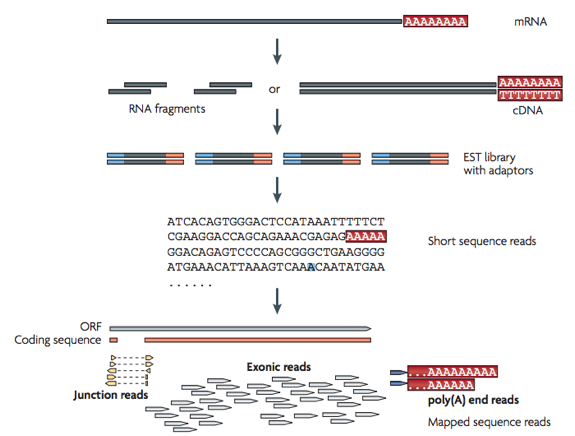
- Викладач: Böttger Angelika
- Викладач: Enard Wolfgang
- Викладач: Hellmann Ines
Content: This lecture builds on knowledge obtained in molecular biology and genetics on the Bachelor's level. It aims to deepen an understanding how the human genome was sequenced and annotated and how it is currently used to study human biology in health and disease. The following topics are addressed: The human genome project, high throughput sequencing technologies, basics in sequence analysis, gene annotation, gene expression analysis.
Qualification goals: The students will be able to describe and understand fundamental principles of human genomic research. They will acquire the basic background knowledge to apply genomic technologies.

- Викладач: Enard Wolfgang
- Викладач: Hellmann Ines
Diese Vorlesung ist Teil des Moduls P 1 „Allgemeine und Organismische Biologie“ im Bachelor Biologie.Ziel der Vorlesung ist es die Prinzipien, die Geschichte und die Aktualität verschiedener biologischer Forschungsgebiete kennenzulernen.
Voraussichtlich findet diese Vorlesung ausschließlich online statt. Der Inhalt ist je nach Dozent*in unterschiedlich aufbereitet, aber besteht im Allgemeinen aus einem live Zoom meeting am Mittwochs von 14:00 – max. 15:30, links zu Vorlesungsvideos und pdfs der Vorlesungsfolien.
Die Inhalte der Vorlesung werden zusammen mit der Vorlesung „Formen- und Artenvielfalt“ in einer schriftlichen Klausur geprüft.

- Викладач: Bolle Cordelia
- Викладач: Enard Wolfgang
- Викладач: Gompel Nicolas
- Викладач: Gottschling Marc
- Викладач: Grothe Benedikt
- Викладач: Haszprunar Gerhard
- Викладач: Hellmann Ines
- Викладач: Heß Martin
- Викладач: Jung Kirsten
- Викладач: Kunz Hans-Henning
- Викладач: Leister Dario
- Викладач: Leonhardt Heinrich
- Викладач: Meilinger Daniela
- Викладач: Meurer Jörg
- Викладач: Nickelsen Kärin
- Викладач: Obst Reinhard
- Викладач: Parniske Martin
- Викладач: Stibor Herwig
- Викладач: Wlodarska-Lauer Grazyna
- Викладач: Wolf Jochen
- Викладач: Zhao Ming
- Викладач: Zink Albert
Dies ist der Moodle für die Vorlesung (P12.1) und die Übung zur Vorlesung (P12.2) Humanbiologie 1 für Biologie Bachelor, Lehramt und Nebenfachstudierende der alten Studienordnung (Start WS19/20 und davor).
Die erste Hälfte – Anthropologie – wird von Frau Gruppe gelesen und organisiert. Die zweite Hälfte – Humangenetik – wird von Herrn Enard gelesen und organisiert. Weitere Informationen finden sich in den entsprechenden zwei Abschnitten.
Sie findet im WS20/21 letztmalig statt da die Inhalte in die verschiedenen Säulen organsimische Biologie, Molekularbiologie und Physiologie aufgehen.
- Викладач: Enard Wolfgang
- Викладач: Göhring Andrea
- Викладач: Grupe Gisela
- Викладач: Hellmann Ines
Computational early drug discovery in cancer; Analysing drug high-throughput screens of cancer cell lines and their deep molecular characterisation for biomarker discovery; Investigating putative drug targets with CRISPR depletion screens. Retrieving insights in the disease aetiology of cancer by analysing large patient cohorts; In this purely computational course, we will investigate pharmacogenomic data, which will be harnessed by applying biostatistical and machine learning methods.

- Викладач: Hellmann Ines
- Викладач: Menden Michael
Current topics in our research field are discussed and priority is given for for students doing research course, Bachelor thesis or Master thesis; This seminar is only recommended for advanced students with an aptitude for quantitative and statistical approaches. 3 ECTS Points
Content: In the seminar, the students critically present and discuss current publications related to genomic analyses.
Qualification goals: The students will be able to extract and judge relevant information also from complex literature and to exchange information and ideas on a scientific level with experts in Genomics.
- Викладач: Enard Wolfgang
- Викладач: Hellmann Ines
- Викладач: Janjic Aleksandar
- Викладач: Janßen Philipp
- Викладач: Vieth Beate
Handling statistical data is the key to success in many fields of biology. In this practical course we will
- discuss how you can use plots to make friends with your data
- discuss how you prepare publication ready plots
- repeat some basic concepts in of statistics
- apply the concepts to interpret published figures
All this will be accomplished using R and ggplot2.
Some basic statistics knowledge is required. To get the 3 ECTS points a term paper needs to be handed in at the end.

- Викладач: Hellmann Ines
- Викладач: Windorfer Laura
- Викладач: Hellmann Ines
- Викладач: Kliesmete Zane
This seminar introduces methods for the computational analysis of quantitative high-throughput RNA sequencing data (RNA-Seq). The seminar is required for the practical course "Computational analysis of RNA-Seq" and the lecture "Human Genomics" is highly recommended.
Instructors: Ines Hellmann hellmann@bio.lmu.de
Beate Vieth vieth@bio.lmu.de
Please remember that you have to consult with one of us at least 2 days prior to the Seminar.
Talks should be 20min/person and including discussion each section should be roughly 1.5h.
The points given in each topics are hints, you may restructure it and make slight changes to the emphasis if you think it to be appropriate.
Talks are generally better if, you consider the following principles:
Less text, more pictures
Text and pictures need to be in sync
Explain everything to a level that your fellow students understand the pictures and statements you make. Don't just show things for the sake showing.

- Викладач: Edenhofer Fiona
- Викладач: Hellmann Ines
